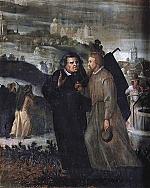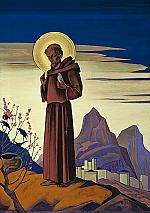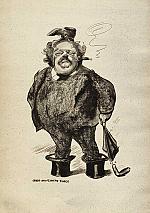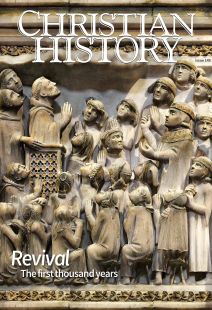Dormant and exploding volcanos
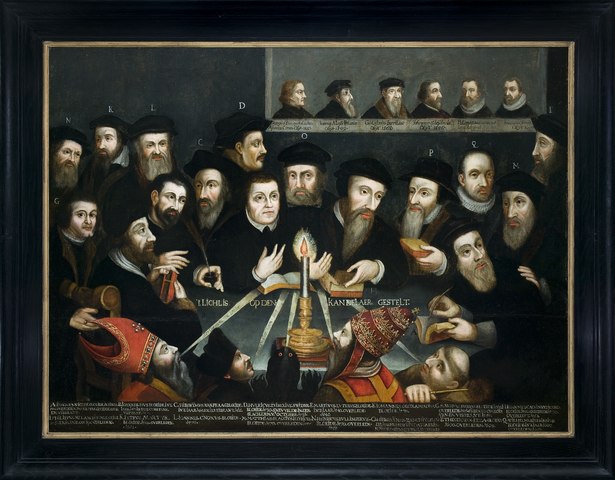
[Anonymous, The light is set on the candlestick, oil on canvas, 1650 to 1699—Museum Catharijneconvent / [CC0 1.0] Wikimedia File:MCC-41878 't licht is op den kandelaer gestelt (1).tif]
Early sixteenth-century Western Europe experienced one of the most dramatic and rapid religious changes in the history of Christianity. A network of primarily young humanist-trained theologians and other intellectuals, most within the boundaries of the Holy Roman Empire, argued that the existing theology and practice of Catholic Christianity had developed in ways that contradicted or undermined key teachings of Scripture.
Many local European rulers listened to these intellectuals, changing the doctrines and practices of the state churches in their territories. When the Reichstag, the representative body governing the empire along with the emperor, voted to stop these religious changes in 1529 under imperial pressure, the princes and city-states that favored the changes “protested” against the order, leading to the moniker “Protestant,” initially a political term.
Comfortable tidings
The word these reformers preferred for themselves, however, was “evangelical.” They believed they had recovered the biblical gospel, the good news of salvation through faith in Jesus. They believed this message had the potential to restore church and society. The most radical and influential evangelical was Augustinian friar Martin Luther (1483–1546), but contemporaries such as Huldrych Zwingli (1484–1531) and Gasparo Contarini (1483–1542) claimed to have made the same discovery independently. The experience Luther described of moving from the terrors of the law to the consolation of the gospel spoke to many in early modern Europe. As William Tyndale put it in Pathway into the Holy Scriptures,
The wretched man (that knoweth himself to be wrapped in sin, and in danger to death and hell) can hear no more joyous a thing, than such glad and comfortable tidings of Christ so that he cannot but be glad, and laugh from the low bottom of his heart, if he believe that these tidings are true.
In the early 1520s, in the teeth of opposition from papal and imperial authorities, it looked very much as if this evangelical movement would be a massive populist surge, transforming and unifying the fractious and often violent world of late medieval Europe. Luther flooded Germany with vernacular pamphlets while simultaneously articulating his increasingly radical theology of salvation in Latin treatises and lectures. In Switzerland Zwingli proclaimed a message of obedience to the Word of God as the path to societal and church renewal.
In city after city across Germany and Switzerland, groups of devout laypeople and clergy began pressuring city governments to allow evangelical preaching and to reform church and society based on that preaching. Such preaching had occurred throughout the later Middle Ages (see pp. 39–42), but the message now clearly conflicted with significant aspects of late medieval Catholicism.
Historians often refer to an “urban reformation” in the cities of southern Germany and Switzerland. But it affected rural areas as well. In Germany local communities had considerable self-government, often in conflict with feudal authorities. Luther called for each community to be able to choose its own pastor rather than having a priest imposed by a distant hierarchy. This call, and Luther’s message of Christian freedom more broadly, resonated across Germany.
Radical prophets
One populist manifestation of this was the claim that the Holy Spirit could speak to people directly, unmediated by church hierarchy or the work of learned theologians such as Luther. In the town of Zwickau, about 90 miles south of Wittenberg, the town government exiled a group of men who claimed to hear messages directly from God. These “Zwickau prophets” showed up in Wittenberg in early 1522, while Luther was in hiding in the Wartburg.
Andreas von Carlstadt (1486–1541), one of Luther’s colleagues at the university, listened respectfully to their ideas. But Luther, intensely perturbed, returned in disguise to urge Wittenberg’s people not to listen to them. He argued that changes should proceed slowly, under the authority of the local government, and with concern for the “weak” who were not ready to see their form of worship altered.
In 1524–1525 a massive uprising broke out across Germany and in its neighboring areas. Often called the “Peasants’ War,” the uprising included miners and members of the urban working classes as well as poor farmers. Economic changes and conflicts with the nobility over land use, rent, and traditional rights enjoyed by the peasants provoked the rebellion. But it had a spiritual component as well.
The rebellion’s most famous manifesto, the “Twelve Articles” of the Swabian rebels, made demands rooted in what the rebels believed to be the law of God as revealed in Scripture. It called for their right to appoint their own pastors and asked for the abolition of serfdom since “Christ has delivered and redeemed us all, without exception, by the shedding of His precious blood, the lowly as well as the great.”
Radical theologian Thomas Müntzer (c. 1490–1525), an associate of the Zwickau prophets, joined the rebellion and encouraged it with his fiery preaching. Müntzer believed the kingdom of God proclaimed in Daniel was at hand and that the true reformation involved the overthrow of all corrupt and tyrannical authority, in the state as well as in the church.
While Luther initially called for the nobility to listen to the peasants and to treat them with moderation, he increasingly came to see the peasants’ use of violence as evidence they were serving the devil and perverting the gospel. His understanding of Christian vocation focused on civil order as an act of love. To be a true follower of the gospel did not mean overthrowing the existing order, but acting lovingly within it. The way to bring people to the gospel was through an alliance with civil authorities that would allow the preaching of right doctrine and good morals, the orderly celebration of the sacraments, and church discipline.
Luther denounced “preachers of murder” who encouraged violence against authorities. This certainly meant Müntzer, but possibly also Zwingli, with whom Luther had growing disagreements—including over Zwingli’s belief that the gospel mandated social and political reform. When Zwingli died in battle against Swiss Catholics in 1531, Luther gloated he had reaped the fruit of his own false teachings.
Zwingli had already experienced problems in Zurich with those more radical than him. Conrad Grebel (c. 1498–1526), Felix Manz (c. 1498–1527), and George Blaurock (c. 1491–1529) grew tired of Zwingli’s willingness to wait for the city government’s approval before changing worship. Eventually they came to believe that infant baptism had no biblical basis and baptized each other, inaugurating the Anabaptist movement. Zwingli condemned them and encouraged the city government to repress them, leading to the execution of Manz by drowning in 1527.
While radicals like the Anabaptists believed they were following through on the original evangelical vision, their magisterial Reformation critics claimed they had missed the point entirely and were falling back into the same errors as the “papists.” Luther argued the Anabaptists represented a new kind of “monkery,” seeking to justify themselves before God by acts of obedience. Zwingli suggested that the sense of joy and liberation Anabaptists felt during adult baptism was similar to the feeling experienced in the Catholic confessional and was, like that feeling, irrelevant spiritually.
Blood and despair
During the late 1520s and the 1530s, mainstream Protestant leaders became increasingly concerned that radical, populist reform was dangerous, perhaps even diabolical. One particularly charismatic Anabaptist leader, Melchior Hoffman (c. 1495–c. 1543), inspired a mass movement of repentance and preparation for the Second Coming, which he initially proclaimed in Strasbourg. After Strasbourg authorities imprisoned him, many of his followers came to believe Jesus would come to the northern German city of Munster instead.
They flocked to Munster and, in 1534, created a utopian community in which social differences and private property were abolished. Under siege from the bishop of Munster’s armies, theocratic leaders seized power and began practicing polygamy and beheading the opposition. The city fell in 1535 after a long siege, and the Anabaptists were slaughtered. A movement that began in joyful hope had ended in fanaticism, blood, and despair.
Menno Simons (1496–1561) organized the remnants of Hoffman’s followers and other scattered, persecuted groups into an ordered community not dependent on the state. The Mennonites—the organized movement emerging from the ashes of early radical Anabaptism—practiced church discipline more strictly than any state church, causing Reformed champions of such discipline such as Martin Bucer (1491–1551) and John Calvin (1509–1564) to envy their Anabaptist rivals even as they denounced them. A populist renewal movement had become a disciplined, isolated minority.
As the Lutheran expression of Protestantism in northern Germany and Scandinavia came to distinguish itself more and more from the Reformed expression in southern Germany and Switzerland, it clearly sided with submission to governmental authority and to the learned clergy appointed by civil authorities.
But Lutheran theology, however academic and politically sedate, always throbbed with the pulse of the gospel Luther had proclaimed: that Christ has set us free from the anxiety of seeking to please God by our works, so that in joyful gratitude for the gift of grace we might serve one another in love. Over and over again in the centuries to come, that message would bubble out from the sober channels in which Lutheran authorities of both church and state sought to confine it.
The Reformed tradition went through a similar process of “confessionalization,” taking widely different forms in different regions. In much of Germany, as well as in England in what would eventually be known as Anglicanism, the Reformed resembled Lutheranism with more austerity, although England was never as austere as the Continent.
Soon a more radical wing once again emerged in England; the Puritan movement, within (and eventually out of) the official state church. Contrary to popular depictions, Puritans were not joyless extremists. They sought to revive the faith of their nation through preaching that awakened consciences, through small Bible study groups, and through a flood of religious literature calling on people to repent and believe the gospel and live lives of holiness.
Rival confessions
Meanwhile many Catholic evangelicals, particularly those living where the government remained firmly aligned with Rome, sought to live out the spiritually transformative insight of justification by faith while remaining in communion with Rome and faithful to Catholic sacramental practice.
Contarini, a Venetian diplomat and cardinal who supervised the last serious Catholic attempt at rapprochement with Protestants in 1541, experienced God’s grace powerfully during sacramental confession. He recognized that Luther had described the same experience of unconditional forgiveness and sought to find room for it within Catholic theology. Spanish preacher Constantino Ponce de la Fuente (1502–1560) proclaimed a message of forgiveness by grace through faith while carefully seeking to remain within Catholic orthodoxy; in the end this did not save him from arrest and condemnation by the Inquisition.
Other Catholic renewal movements more successfully gained church authorities’ favor. Ignatius of Loyola (1491–1556) experienced a powerful personal conversion and created a new religious order dedicated to reawakening the faith of Catholics as well as evangelizing non-Christians (and, eventually, reconverting Protestants, though that was not his initial purpose). Teresa of Ávila (1515–1582) and John of the Cross (1542–1591) reformed the Carmelite order after mystical experiences.
Across the Catholic world during the later 1500s, these and other religious movements with the full backing of Rome sought to renew the faith and spiritual experience of baptized Catholics. These approved movements steered clear of anything that sounded like “Protestant” language about justification by faith, focusing rather on increasing love and devotion to Christ through passionate preaching and emotionally moving art and music.
Thus Western Christianity went into the seventeenth century divided into rival confessions, each of which had an official, government-sponsored set of beliefs and practices. These official confessions promoted piety but sought to repress unauthorized expressions of spiritual hunger, especially those looking too much like their rivals. Meanwhile the radical impulse of the early Anabaptist movement had been channeled into a minority away from the mainstream.
But the hopes that had burned so high for a short time in the 1520s never went away. The lofty mountains of doctrine, liturgy, and government-imposed godly order that faced each other across the European landscape by the end of the sixteenth century were all, it turned out, barely dormant volcanoes of explosive faith and hope. Hope for the coming of God’s kingdom, for true justice, for a relationship with God characterized by joy and love and gratitude rather than merely by dutiful fear and diligent obedience. And these hopes exploded again and again in the centuries to come. They have not ceased to do so. CH
By Edwin Woodruff Tait
[Christian History originally published this article in Christian History Issue #149 in 2023]
Edwin Woodruff Tait is a contributing editor of Christian History.Next articles
What does it mean to live in Christ?
Reforming and challenging words from Martin Luther
Martin Luther and translatorsQuestions for reflection: Renewal, revival, and reform
Use these questions on your own or in a group to reflect on medieval renewal movements.
the editorsRecommended resources: Medieval renewals
Read more about revival, renewal, and reform in the Middle Ages in these resources recommended by our authors and the CH team
the editors and authorsDid you know? Best of CH
Memorable “Did you know?” facts from 150 issues of CH
editors and contributorsSupport us
Christian History Institute (CHI) is a non-profit Pennsylvania corporation founded in 1982. Your donations support the continuation of this ministry
Donate



